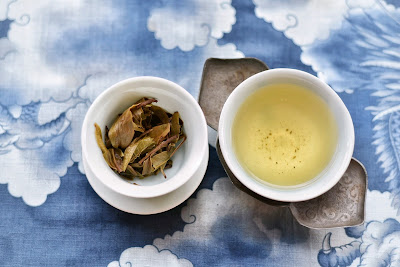 |
| Jasmine plantation in Huatan, Changhua county, Taiwan |
The first secret of (good) jasmine tea is... real jasmine flowers! Today's chemical companies have come up with so many artificial flavors that most cheap teas are not 'scented' with real flowers but 'flavored' with all kinds of fragrances. But this cost reduction has always existed. In the past (and still today) one common way to reduce the cost of using jasmine flowers was to use bigger and more powerful flowers (like Yulan) instead of small jasmine flowers. This unbalanced competition between artificial flavors and real flowers has caused the closing of most jasmine producers in Taiwan...
Jasmine flowers are harvested between June and September, when temperatures exceed 26/28 degrees Celcius (80 deg. Fahrenheit). They are closed during the day and become really fragrant during the night. They can be used for 7 days and are then thrown away.
Here is how the scenting happens:
The flowers are spread on and around the tea. The tea leaves are not spread thin, but grouped in the shape of a mount in order to reduce their interaction with air. And since we are on the subject of the tea leaves, here comes the second second secret of jasmine tea: the leaves that are used come from the second spring harvests (in June). The first spring harvests are much more expensive and don't require the addition of jasmine scents to sell. The second harvests happen at a time when the temperatures are higher and produce a stronger taste, but less refined scents. It's for those green teas or lightly oxidized Oolongs that the scenting with jasmine makes most sense.
Why are the leaves of jasmine tea cut small?
To answer this question, I have to reveal the third secret of jasmine tea: the flowers loose all their fragrance after 7 days. But their petals have a high moisture level and if you'd continue to keep them in contact with the tea, the leaves would oxidize and loose their freshness. That's why you have to separate the flowers from the tea after the scenting process (and the tea needs to be further dried). This separation happens on this machine that shakes the leaves and flowers. The smaller tea parts fall through the grid, while only the flowers remain at the end of the sorting machine. (See below)
While it's normal that small fragments of petals will also be present in the jasmine tea, actually most of the flowers are thrown away because they don't smell nice anymore. So, if you see lots of dry jasmine flowers in your jasmine tea, something's not right. It might be a trick to let you think that the tea was scented with real flowers...
 |
| Jasmine flowers land in the garbage bin! |
1. the number of times that the tea leaves are scented with jasmine flowers. Usually, it's 3 times, but for top quality it's 6 times and for imperial quality it's 10 times.
2. the quality of the leaves also varies with quality. The sorting machine also sorts between thick and thin leaves. The imperial quality only uses the finest leaves, the top quality is a mix of both and normal jasmine tea uses thick leaves.
There are many ways of preparing jasmine tea. Here is one of the easiest and it comes with a little trick. Use roughly only 1 gram of tea for your gaiwan. After you've preheated your gaiwan, fill it half with boiling water. Then add the leaves to the water and pour water again slowly on these leaves. Doing so is gentler for the leaves. It's a way to slightly reduce the temperature of the water.
As they brew, the leaves will sink to the bottom and it's possible to drink directly from the gaiwan and use the lid as a filter. This is a very common way to drink jasmine tea in China. You continuously add boiling water when you almost finish your cup.
In order to avoid over-brewing the tea, it's best to use very few leaves and drink quickly while the tea is hot.
Jasmine scented tea isn't just a very nice casual tea, it's also a good tea pairing choice for Shanghai style cuisine. (The dumpling restaurant Ding Tai Fong is serving jasmine tea to its customers).
Three types of 2017 jasmine scented teas are now available in my selection. And, for a limited time, I am giving away 25 gr samples of this jasmine tea from 2016 for any purchase of 60 USD or more (excluding shipping) on my online tea boutique.































































